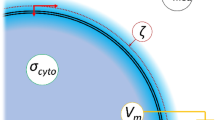Summary
Maleic anhydride (MA) has been shown to react specifically and rapidly with amino groups of proteins; the maleyl amino groups are negatively charged and completely stable at neutral pH. Treatment of human red cells with this reagent results in a significant increase in K+ permeability which is associated with a much smaller increase in Na+ permeability. Opposite effects are observed on anion permeability, the SO −−4 and Cl− permeability being decreased to an approximately similar extent upon treatment with MA.
Studies on the distribution of MA between membrane lipids and proteins shows that most of the membrane-bound MA is associated with membrane proteins. These results suggest that the observed effects of MA on the ion permeability of the red cell are caused by its combination with amino groups of cell membrane proteins.
Similar content being viewed by others
References
Adair, G. S., Robinson, M. E. 1930. The analysis of the osmotic pressure of the serum proteins and the molecular weights of albumins and globulins.Biochem. J. 24:1864.
Bohner, L. S., Soto, E. F., Cohan, T. 1965. Quantitative analysis of phospholipids by thin-layer chromatography.J. Chromatog. 17:513.
Bray, G. A. 1960. A simple efficient liquid scintillator for counting aqueous solutions in a liquid scintillation counter.Analyt. Biochem. 1:279.
Butler, P. D. J., Harris, J. I., Hartley, B. S., Leberman, R. 1969. The use of maleic anhydride for the reversible blocking of amino groups in polypeptide chains.Biochem. J. 122:679.
Dalmark, M., Wieth, J. O. 1970. Chloride and sodium permeabilities of human red cells.Biochim. Biophys. Acta 112:679.
Folin, O., Wu, H. 1919. A system for blood analysis.J. Biol. Chem. 38:81.
Garrahan, P. J., Pouchan, M. I., Rega, A. F. 1969. Potassium activated phosphatase from human red blood cells. The mechanism of potassium activation.J. Physiol. 202:305.
Garrahan, P. J., Rega, A. F. 1967. Cation loading of red blood cells.J. Physiol. 193:459.
Hunter, M. J. 1971. A quantitative estimate of the non-exchange-restricted chloride permeability of the human red cell.J. Physiol. 218:49P.
Katz, B. 1966. Nerve, Muscle and Synapse. McGraw-Hill Book Co., Inc., New York, p. 60.
Knauf, P. A., Rothstein, A. 1971. Chemical modification of membranes. I. Effects of sulfhydryl and amino reactive reagents an anion and cation permeability of the human red blood cell.J. Gen. Physiol. 58:190.
Lew, V. L. 1970. Effect of intracellular calcium on the potassium permeability of human red cells.J. Physiol. 206:35P.
Passow, H. 1969. Passive ion permeability of the erythrocyte membrane. An assessment of the scope and limitations of the fixed charge hypothesis.Prog. Biophys. Mol. Biol. 19:425.
Passow, H., Schnell, K. F. 1969. Chemical modifiers of passive ion permeability of the erythrocyte membrane.Experientia 25:460.
Pfleger, K., Rummel, W., Seifen, E. 1967. Sodium and potassium permeability of red blood cells in dependence of the pH.Pflüg. Arch. Ges. Physiol. 295:255.
Poensgen, J., Passow, H. 1971. Action of 1-fluoro-2,4-dinitrobenzene on passive ion permeability of the human red blood cell.J. Membrane Biol. 6:210.
Reed, C. F., Swisher, S. N., Marinetti, G. V., Eden, E. G. 1960. Studies of the lipids of the erythrocyte. I. Quantitative analysis of the lipids of normal human red blood cells.J. Lab. Clin. Med. 56:281.
Savitz, D., Sidel, V. W., Solomon, A. K. 1964. Osmotic properties of human red cells.J. Gen. Physiol. 48:79.
Schales, O., Schales, S. 1941. A simple and accurate method for the determination of chloride in biological fluids.J. Biol. Chem. 140:879.
Sutherland, R. M., Rothstein, A., Weed, R. I. 1967. Erythrocyte membrane sulfhydryl groups and cation permeability.J. Cell. Physiol. 69:185.
Whittam, R. 1968. Control of membrane permeability to potassium in red blood cells.Nature 219:610.
Author information
Authors and Affiliations
Additional information
Fellow of the Consejo Nacional de Investigaciones Científicas y Técnicas, Argentina (CONICET).
Established Investigators of CONICET.
Rights and permissions
About this article
Cite this article
Obaid, A.L., Rega, A.F. & Garrahan, P.J. The effects of maleic anhydride on the ionic permeability of red cells. J. Membrain Biol. 9, 385–401 (1972). https://doi.org/10.1007/BF01868064
Received:
Issue Date:
DOI: https://doi.org/10.1007/BF01868064



